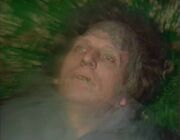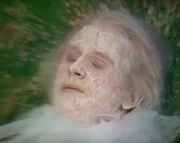LauraBatham (talk | contribs) Tag: Visual edit |
Crockalley (talk | contribs) m (→An ambiguous Doctor: Un-complicating some sentences) Tag: Visual edit |
||
| Line 28: | Line 28: | ||
== Behind the scenes == |
== Behind the scenes == |
||
=== An ambiguous Doctor === |
=== An ambiguous Doctor === |
||
| − | [[File:Fifth... Watcher? (Logopolis).jpg|thumb|After merging with the Watcher, the [[Fourth Doctor]] first morphs into [[Peter Davison]] in Watcher make-up before the renewal completes itself. The implications are as numerous as they are confusing. ([[TV]]: ''[[Logopolis (TV story)|Logopolis]]'')]] |
+ | [[File:Fifth... Watcher? (Logopolis).jpg|thumb|After merging with the Watcher, the [[Fourth Doctor]] first morphs into [[Peter Davison]] in Watcher make-up before the renewal completes itself. The implications are as numerous as they are confusing. ([[TV]]: ''[[Logopolis (TV story)|Logopolis]]'')]]''[[Logopolis (TV story)|Logopolis]]'' takes great pains to leave the Watcher's nature eerily ambiguous, with the eventual statement that "he was the Doctor all along" being all the explanation the viewers got in [[1981 (releases)|1981]]. The information certainly seems to make more sense to the [[companion]]s than it would have to the viewer. The [[Fifth Doctor]] first appearing, in his regeneration scene, as plaster-faced and frayed like the Watcher, might have tied back in some viewers' mind to "Cho Je". Cho Je was the sentient manifestation of [[K'anpo Rimpoche]]'s next incarnation who appears in ''[[Planet of the Spiders (TV story)|Planet of the Spiders]]'' and waits upon his "original" until K'anpo actually regenerates and physically becomes Cho Je. This may cast the Watcher as an incomplete manifestation of the Fifth Doctor. However, this would not explain the Doctor's insistence that "the moment [had] been prepared for", which paints the Watcher as essential to the regenerative process. |
It was only in [[1999 (releases)|1999]] that the novel ''[[Divided Loyalties (novel)|Divided Loyalties]]'' posited that Watchers (plural) were a common phenomenon tied to [[Time Lord]] [[regeneration]], not just for [[the Doctor]]. [[Gary Russell]] defined Watchers as projections of alternative versions of a regenerating Time Lord, insubstantial phantoms of what might have been and might yet be who come into existence thanks to the temporal significance of a Lord of Time changing identities. This now suggested that although the Watcher was an emanation of the Doctor, he was not necessarily an emanation of the ''Fifth'' Doctor as such. This was contradicted in [[2007 (releases)|2007]] when the [[Fifth Doctor]], upon reaching the end of his life, was depicted in ''[[Winter (audio story)|Winter]]'' as encountering the Watcher as an embodiment of his [[Sixth Doctor|unregenerated next self]], and in [[2013 (releases)|2013]], ''[[Trial of the Valeyard (audio story)|Trial of the Valeyard]]'', this take on the nature of the Watcher(s) was formalised: they were now defined as unregenerated projections of the next incarnation. |
It was only in [[1999 (releases)|1999]] that the novel ''[[Divided Loyalties (novel)|Divided Loyalties]]'' posited that Watchers (plural) were a common phenomenon tied to [[Time Lord]] [[regeneration]], not just for [[the Doctor]]. [[Gary Russell]] defined Watchers as projections of alternative versions of a regenerating Time Lord, insubstantial phantoms of what might have been and might yet be who come into existence thanks to the temporal significance of a Lord of Time changing identities. This now suggested that although the Watcher was an emanation of the Doctor, he was not necessarily an emanation of the ''Fifth'' Doctor as such. This was contradicted in [[2007 (releases)|2007]] when the [[Fifth Doctor]], upon reaching the end of his life, was depicted in ''[[Winter (audio story)|Winter]]'' as encountering the Watcher as an embodiment of his [[Sixth Doctor|unregenerated next self]], and in [[2013 (releases)|2013]], ''[[Trial of the Valeyard (audio story)|Trial of the Valeyard]]'', this take on the nature of the Watcher(s) was formalised: they were now defined as unregenerated projections of the next incarnation. |
||
Revision as of 01:50, 13 November 2020
- You may wish to consult
The Watcherfor other, similarly-named pages.
The Watcher was a manifestation of the Doctor who appeared during the events that led up to the regeneration of his fourth incarnation into his fifth. He appeared to the Doctor and his companions, and brought Nyssa to the planet Logopolis.
Appearances
In a dream, the Fourth Doctor saw the Watcher and thought of his next incarnation. (PROSE: Into the Silent Land)
The Watcher silently observed events on Earth, particularly the events leading to Tegan Jovanka entering the Doctor's TARDIS. It was around this time that the Doctor first noticed the Watcher.
Although apparently silent, (TV: Logopolis) the Watcher was capable of telepathic communication. He communicated with the Fourth Doctor, and was seen apparently carrying on a conversation of some sorts, though what was said was unknown. Later, he communicated with the Doctor's companions Adric and Nyssa, who thought his voice seemed familiar. (PROSE: Logopolis) The Watcher, apparently on his own accord, transported Nyssa from her home planet of Traken, a planet which would soon die in the entropy wave, to Logopolis and safety. Later, apparently working on the Doctor's instructions, he piloted the TARDIS from Logopolis to keep Adric, Nyssa and Tegan safe. It was during this voyage that the Watcher engaged Adric in a private conversation; (TV: Logopolis) when trying to recall the Watcher's voice, Adric found he could only imagine the Doctor's. (PROSE: Logopolis)

The Fourth Doctor regenerates, merging with the Watcher. (TV: Logopolis)
As the Fourth Doctor died, the Watcher appeared and merged with the Doctor to create the Doctor's next incarnation. (TV: Logopolis)
During his own regeneration, the Fifth Doctor again saw and merged with a recreation of the Watcher that reflected the Sixth Doctor in his mindscape. (TV: The Caves of Androzani, AUDIO: Winter)
Shortly before his regeneration, the Tenth Doctor saw a solitary pale watcher observing him; shortly after the TARDIS dematerialised, the watcher also disappeared. (PROSE: The Advent of Fear)
Appearance
The Watcher was a ghostly figure with a white, featureless, unformed face and body. He wore white robes. Though he used the Doctor's TARDIS at one point, he apparently had the power to traverse time and space on his own. (TV: Logopolis)
Behind the scenes
An ambiguous Doctor

After merging with the Watcher, the Fourth Doctor first morphs into Peter Davison in Watcher make-up before the renewal completes itself. The implications are as numerous as they are confusing. (TV: Logopolis)
Logopolis takes great pains to leave the Watcher's nature eerily ambiguous, with the eventual statement that "he was the Doctor all along" being all the explanation the viewers got in 1981. The information certainly seems to make more sense to the companions than it would have to the viewer. The Fifth Doctor first appearing, in his regeneration scene, as plaster-faced and frayed like the Watcher, might have tied back in some viewers' mind to "Cho Je". Cho Je was the sentient manifestation of K'anpo Rimpoche's next incarnation who appears in Planet of the Spiders and waits upon his "original" until K'anpo actually regenerates and physically becomes Cho Je. This may cast the Watcher as an incomplete manifestation of the Fifth Doctor. However, this would not explain the Doctor's insistence that "the moment [had] been prepared for", which paints the Watcher as essential to the regenerative process.
It was only in 1999 that the novel Divided Loyalties posited that Watchers (plural) were a common phenomenon tied to Time Lord regeneration, not just for the Doctor. Gary Russell defined Watchers as projections of alternative versions of a regenerating Time Lord, insubstantial phantoms of what might have been and might yet be who come into existence thanks to the temporal significance of a Lord of Time changing identities. This now suggested that although the Watcher was an emanation of the Doctor, he was not necessarily an emanation of the Fifth Doctor as such. This was contradicted in 2007 when the Fifth Doctor, upon reaching the end of his life, was depicted in Winter as encountering the Watcher as an embodiment of his unregenerated next self, and in 2013, Trial of the Valeyard, this take on the nature of the Watcher(s) was formalised: they were now defined as unregenerated projections of the next incarnation.
The nature of the Watcher's conversations with the Doctor and Adric was never revealed either. Logopolis suggests that the Doctor was made aware of his impending regeneration due to his statement. "It's the end, but the moment has been prepared for." The knowledge passed to Adric is never revealed, although after the transformation, Adric does show an unexpected knowledge of regeneration in Castrovalva.
Several other "partial Doctors" have appeared in the history of the series, most notably an evil manifestation, the Valeyard, the main antagonist of Season 23, described in confusing terms by many sources; originally envisioned as a future evil version of the Doctor, he was eventually rephrased as an amalgamation of the Doctor's dark side. Most strikingly, the novelisation of The Ultimate Foe described him as being from "somewhere between the Doctor's twelfth and thirteenth regenerations"; an emanation existing halfway between two incarnations of the Doctor was almost the very definition of the new "canonical" take on the Watcher, leading the audio stories Trial of the Valeyard and He Jests at Scars... to tentatively identify the Valeyard as "the first known fully-independent Watcher". Whether this makes him the same individual as the Watcher seen in Logopolis, or if a single Time Lord can sprout several Watchers, is left unclear.
A second life in the pages of Doctor Who Magazine

The surprisingly talkative "new take" on the Watcher sometimes dawned silly hats, much like contemporary, more conventional incarnations of the Doctor. (NOTVALID: The Watcher's Fiendishly Festive Christmas Quiz!)
Whatever his true nature, the original Watcher as played under heavy make-up by Adrian Gibbs was repurposed in the 21st century in the pages of Doctor Who Magazine as the narrator and main character of a long series of articles straddling the fourth wall. None of the DWM Watcher stories are currently considered valid sources on this Wiki, being fourth-wall-breaking in the extreme, but they unexpectedly make the mysterious Watcher one of the most familiar classic incarnations of the Doctor to the 21st-century Doctor Who fan.
The DWM Watcher stories include several instalments of the annual DWM Christmas Quiz, the regular feature "Wotcha!", defined as "A History of Doctor Who in 100 Objects… Compliled by the Watcher" by its tagline, and some unmarked prose stories, including The Watcher's Guide to… the Tenth Doctor in DWM 416 and Loving the Alien in DWM 484.
